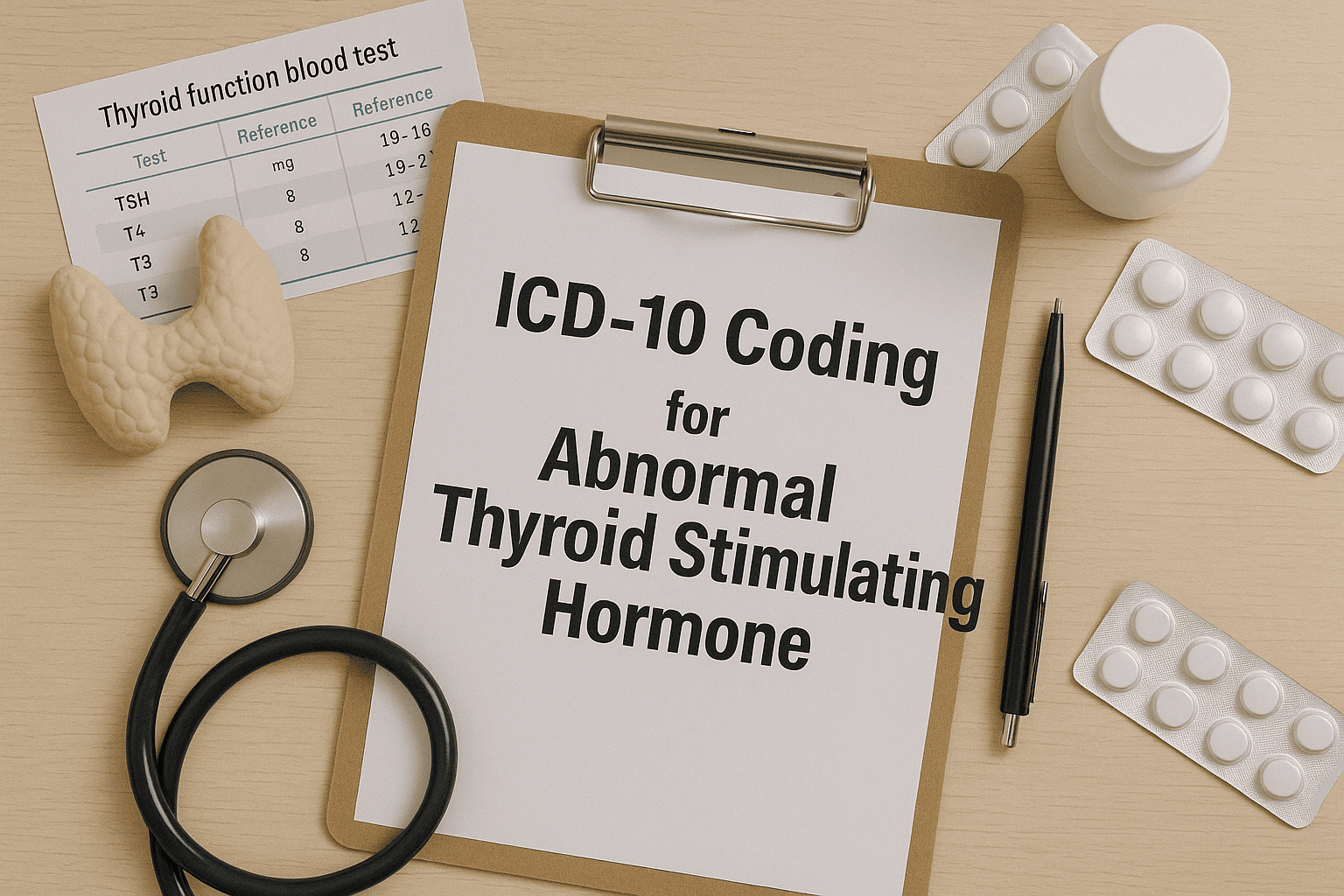Updated on: July 23, 2025
Thyroid disorders are among the most prevalent endocrine conditions globally, and the key to diagnosis often lies in the Thyroid Stimulating Hormone (TSH) levels. Whether elevated or suppressed, abnormal TSH values are crucial diagnostic markers for conditions like hypothyroidism, hyperthyroidism, and thyroiditis.
This guide walks through the clinical implications of abnormal TSH levels, how to document them accurately using ICD-10 codes, and how AI-powered tools like DocScrib can streamline medical documentation and coding for busy clinicians.
What is Thyroid Stimulating Hormone (TSH)?
TSH is a pituitary hormone that regulates the production of T3 (triiodothyronine) and T4 (thyroxine) by the thyroid gland. It works on a feedback loop—high levels typically signal hypothyroidism, and low levels may indicate hyperthyroidism or secondary hypothyroidism.
Normal TSH Range
| Age Group | Normal TSH Range (µIU/mL) |
|---|---|
| Adults | 0.4 – 4.0 |
| Pregnant Women | 0.1 – 2.5 (1st trimester) |
| Children | 0.7 – 6.4 |
Clinical Interpretation of Abnormal TSH
High TSH Levels
-
Most commonly seen in: Primary hypothyroidism
-
Common symptoms: Fatigue, weight gain, cold intolerance, constipation, dry skin
-
Clinical examples:
-
Autoimmune Thyroiditis (Hashimoto’s)
-
Iatrogenic hypothyroidism (e.g., post-thyroidectomy)
-
Congenital hypothyroidism
-
Low TSH Levels
-
Most commonly seen in: Hyperthyroidism
-
Common symptoms: Palpitations, weight loss, anxiety, heat intolerance, tremors
-
Clinical examples:
-
Graves’ Disease
-
Toxic multinodular goiter
-
Thyroiditis in early stages (transient thyrotoxicosis)
-
Central hypothyroidism (pituitary/hypothalamic disorder)
-
ICD-10 Coding for Abnormal TSH
Accurate documentation using ICD-10 codes is essential for proper billing, quality reporting, and continuity of care. Here’s how you can code various thyroid dysfunctions related to abnormal TSH levels.
Common ICD-10 Codes Related to Abnormal TSH
| Condition | ICD-10 Code | Description |
|---|---|---|
| Hypothyroidism, unspecified | E03.9 | General hypothyroidism without specifics |
| Subclinical Hypothyroidism | E02 | Mildly elevated TSH, normal T3/T4 |
| Iatrogenic Hypothyroidism | E89.0 | Post-surgical or radiotherapy-induced |
| Autoimmune Thyroiditis (Hashimoto’s) | E06.3 | Inflammatory autoimmune cause |
| Hyperthyroidism, unspecified | E05.90 | Elevated T3/T4, low TSH |
| Thyrotoxicosis with diffuse goiter | E05.00 | Common in Graves’ Disease |
| Pituitary Hypofunction (Central cause) | E23.0 | Secondary hypothyroidism due to pituitary |
| Abnormal Findings of TSH Lab Test | R94.6 | Non-specific abnormal result on lab test |
💡 Tip: Always document both the lab abnormality (R94.6) and the underlying condition (e.g., E03.9) to support accurate coding and reimbursement.
Clinical Workflow: From Lab Result to Diagnosis
Let’s simplify your workflow using DocScrib’s AI-powered scribe system:
-
Patient Visit:
-
Patient complains of fatigue and weight gain
-
Lab report shows TSH = 10.2 (High)
-
-
DocScrib Suggestion:
-
Prompts likely ICD-10 match: E03.9 (Hypothyroidism)
-
Notes symptom alignment: fatigue, weight gain
-
Recommends tagging R94.6 if condition not yet confirmed
-
-
Generated SOAP Note (via DocScrib):
yamlS: Patient reports 2 months of fatigue, mild constipation, and weight gain.
O: TSH: 10.2; Free T4: 0.7
A: Hypothyroidism (E03.9)
P: Begin Levothyroxine 25 mcg daily, re-check TSH in 6 weeks.
With DocScrib, clinicians can automate documentation, reduce cognitive load, and ensure ICD-10 precision with one click.
Benefits of AI-Powered ICD-10 Documentation for Endocrinologists
| Feature | With DocScrib | Without DocScrib |
|---|---|---|
| Auto-suggest ICD-10 Codes | ✅ Yes, based on symptoms + labs | ❌ Manual lookup |
| Generate SOAP Notes | ✅ Instantly | ❌ Typing + EHR navigation |
| Improve Claim Approval Rate | ✅ Smart coding = fewer denials | ❌ Risk of incomplete codes |
| Saves Time per Consultation | ✅ 6–10 minutes saved | ❌ Time-consuming charting |
| Clinician Satisfaction | ✅ High | ❌ Increased burnout |
Managing Follow-up and Monitoring of Abnormal TSH
Recommended Follow-up Protocols
| Diagnosis | Follow-Up Action | Time Frame |
|---|---|---|
| Subclinical Hypothyroidism | Monitor TSH & Free T4; no immediate Rx | Every 6–12 months |
| Primary Hypothyroidism | Start levothyroxine; monitor TSH after dose | 6–8 weeks post-start |
| Central Hypothyroidism | Imaging, hormone panel | Refer to Endocrinology |
| Hyperthyroidism | TSH + Free T3/T4 + TSI/Thyroid scan | Specialist referral often required |
FAQs: Abnormal TSH & ICD-10
Q1: Can I code R94.6 (Abnormal TSH) without a definitive diagnosis?
Yes, but it’s better to pair it with a confirmed diagnosis (like E03.9) once established.
Q2: Should I document symptoms even when labs are diagnostic?
Absolutely. Documenting symptoms supports clinical justification and medical necessity for insurers.
Q3: What if the patient has both hypo and hyperthyroid phases (e.g., thyroiditis)?
Use sequential or combination coding based on the dominant clinical picture. DocScrib can auto-suggest time-based coding adjustments.
Q4: How can I avoid claim denials for thyroid conditions?
Always match symptoms, lab findings, and ICD-10 codes in your documentation. Use precise terminology like “Subclinical Hypothyroidism” vs. “Mild Hypothyroidism.”
Elevate Your Documentation Game with DocScrib
AI-powered documentation is no longer a futuristic concept—it’s here, and it’s transforming how clinicians work. DocScrib empowers endocrinologists, internists, and PCPs to:
-
Accurately code thyroid disorders
-
Save 2–3 hours per day
-
Improve billing compliance
-
Enhance patient safety through structured notes
👉 Ready to automate your thyroid documentation?
Book a free demo today:
Schedule a Call with DocScrib
Final Thoughts
Abnormal TSH levels are clinically significant indicators that demand timely diagnosis and structured documentation. With rising administrative burden, tools like DocScrib enable clinicians to strike the perfect balance between clinical excellence and operational efficiency.
If you’re looking to simplify ICD-10 coding for thyroid conditions and elevate the quality of your notes—DocScrib is your AI assistant that never tires.
🔗 Learn more at DocScrib.com
